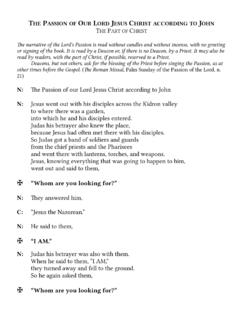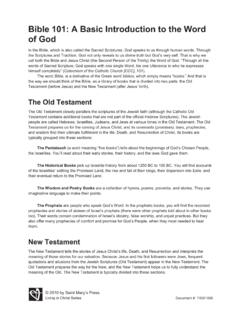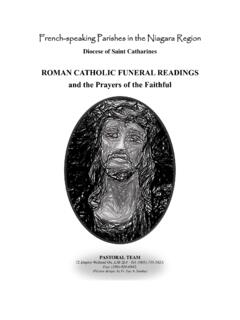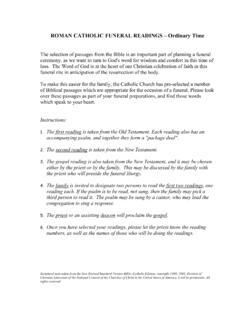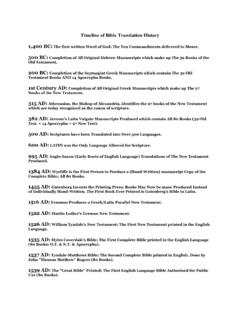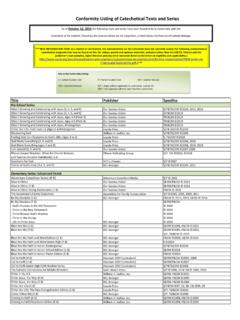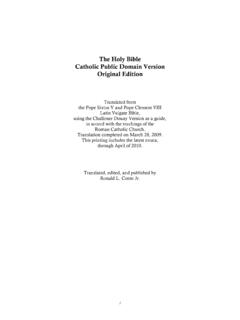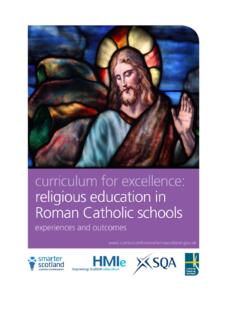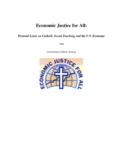Transcription of What Will I See in a Catholic Church? - Ipsissima Verba
1 What Will I See in a Catholic Church? What Happens in the Church? The church building is used for many different types of prayer, public and ) The church is primarily used for the celebration of the sacred liturgy, the official public prayer of the church :The Sacrifice of the sacraments, , Baptism, Confession, and of the Blessed Sacrament and Celebration of the Liturgy of the ) The church is also used for the celebration of devotions, public or private expressions of prayer accepted and endorsed by the church :The Stations of the in front of sacred images and ) Finally, the church is available for people to come for private prayer before the Blessed Sacrament reserved in the layout of the church building and the sacred objects and furnishings found within the church exist to serve these different types of church building itself can be considered the house of God and the house of the church , God's holy people, a spiritual temple (1 Pet.
2 2:4 5).A Typical church LayoutThe Sanctuary: The elevated portion of the church where the clergy and other ministers perform their proper functions in the worship of God. The sanctuary symbolizes Nave: The main body of the church where the congregation Narthex: The lobby or gathering space outside of the church Blessed Sacrament Chapel: The chapel where the tabernacle is located for the faithful to come and Sacristy: The room where the sacred vestments, vessels, and other items used in the celebration of the liturgy are stored and Apse: The curved area behind the altar where the tabernacle is located in many Altar: The sacred table on which the sacrifice of the Mass is offered to God; the table from which the faithful receive the Blessed Ambo: The lectern from which the readings are Presider's Chair: The chair on which the priest sits during Credence Table: The table on which objects are kept during the celebration of Tabernacle: (Latin: tabernaculum, tent ) The golden container in which the Blessed Sacrament is reserved.
3 The name derives from the old testament tent in which God dwelt among his Pews: The benches on which the congregation Ambry: The cabinet in which the three holy oils are and RolesThe liturgy (official public worship) of the church is essentially hierarchical, that is, everything is ordered, and in liturgical celebrations each person, minister or layman, who has an office to perform, should do all of, but only, those parts which pertain to his office by the nature of the rite and the principles of liturgy. 1 Bishop: The bishop has the fullness of the priesthood. The essence of the priesthood is to offer sacrifice as a mediator between God and The bishop, moreover, is a source of unity for his : The priest has the lower degree of the : The deacon is the lowest-ranking cleric. He shares in Christ's servanthood. At Mass, he assists the bishop or the priest, chants or proclaims the Gospel, and gives instructions to the congregation, such as Let us offer each other the sign of peace, or The Mass is ended, go in peace.
4 Acolyte: The instituted acolyte4 (rarely found in America) assists the priest and the deacon at the : The instituted lector (rarely found in America) proclaims the readings except for the Gospel. In most parishes in America, this function is performed by other lay Server: The server assists the priest and deacon (and acolyte) at the altar. In the older form of Mass, the servers were responsible for making the responses on behalf of the entire Vatican Council, Sacrosanctum concilium, n. 5:1: For every high priest chosen from among men is appointed to act on behalf of men in relation to God, to offer gifts and sacrifices for sins. 3 Ignatius of Antioch (c. 107), Letter to the Smyrnaeans: Apart from the bishop, let no one perform any of the functions that pertain to the church . Let the Eucharist be held valid which is offered by the bishop or by one to whom the bishop has committed this charge.
5 Wherever the bishop appears, there let the people be; as wherever Jesus Christ is, there is the Catholic church . 4 For information on the instituted acolyte and lector, see Paul VI, Ministeria quaedam (1972).Congregation: The congregation consists of the lay faithful of the local church who have gathered for the worship of God. It is, therefore, desirable .. that all the faithful should be aware that to participate in the eucharistic sacrifice is their chief duty and supreme dignity, and that not in an inert and negligent fashion, giving way to distractions and day-dreaming, but with such earnestness and concentration that they may be united as closely as possible with the High Priest, according to the Apostle, 'Let this mind be in you which was also in Christ Jesus.' And together with Him and through Him let them make their oblation, and in union with Him let them offer up themselves.
6 5 Sacristan: The person who prepares the requisite materials for the celebration of Minister of Holy Communion: The extraordinary minister of Holy Communion (so-called to distinguish from the ordinary ministers of Holy Communion, , the bishop, priest, and deacon, who have this function because of their role in the church ) is a duly-delegated lay person who assists in distributing Holy Communion due to grave necessity, when the Priest and Deacon are lacking, when the Priest is prevented by weakness or advanced age or some other genuine reason, or when the number of faithful coming to Communion is so great that the very celebration of Mass would be unduly prolonged. 6 The Sacred Vessels and Other VesselsThe chalice: The vessel which holds the wine that becomes the Precious Blood of paten: The golden plate that holds the bread that becomes the Sacred Body of Communion paten: The golden plate that is used at the 5 Pius XII, Mediator Dei (1947), n.
7 For Divine Worship and the Discipline of the Sacraments, Instruction Redemptionis Sacramentum (25 March 2004), n. of the faithful to catch any particle of the Host that may accidentally fall at that ciborium: A golden vessel with a lid that is used for the distribution and reservation of pyx: A small, closing golden vessel that is used to bring the Blessed Sacrament to those who cannot come to the monstrance: An ornate vessel used to display the Blessed Sacrament for public ablution cup: A small container of water that sits near the tabernacle or on the credence table for the priest to wash his fingers of any particles of the Host after the distribution of Holy cruets: The cruets hold the wine and the water that are used at lavabo dish: The dish that is used for washing the priest's hands. Its name comes from the psalm (Ps. 26:6: Lavabo = I will wash ) that was recited in the older form of Mass during the washing of the aspersorium: The bucket used to carry holy water for aspergillum: The sprinkler for casting holy water on people, places, or Altar LinensThe corporal: The corporal (Latin: corporale from corpus, body ) is a square cloth placed on the altar beneath the chalice and paten.
8 It is folded so as to catch any particles of the Host that may accidentally purificator: The purificator (Latin: purificatorium) is a small rectangular cloth used for wiping the pall: The pall (Latin: palla, cover ) is a stiff square cloth used to cover the chalice during Mass to prevent dust from settling in it or anything from falling into lavabo towel (Finger towel): The towel with which the priest dries his hands after washing them during the altar cloth: A rectangular white cloth that covers the altar for the celebration of amice: The amice (Latin: amictus, garment ) is a rectangular linen cloth used by those who wear an alb if the alb does not completely cover the clothing at the neck,7 the reason being that in the sacred liturgy, the minister's common clothing should be completely covered since he does not act as himself but in an official capacity.
9 The amice is called the helmet of salvation (cf. Eph 6:17) (it was worn even on the head in former times) and is worn with the prayer that the wearer be protected from the assaults of demons, who wish to distract his mind from attentiveness to the sacred action he is about to alb: The alb (Latin: alba, white ) is a full-length white garment worn by the priest and deacon. In some places, it is also worn by others, , servers or lectors. It symbolizes purity of heart as well as the white garment given in cincture: The cincture (Latin: cingulum, belt ) is worn around the alb if it does not fit closely to the It symbolizes stole: The stole (Latin: stola, robe ) is a long strip of fabric worn around the neck. It matches the color of the day. Priests wear the stole around the neck and over the breast. Deacons wear the stole diagonally from the left shoulder to the right side.
10 The stole 7 General Instruction of the Roman Missal (2002), n. Instruction of the Roman Missal (2002), n. the office or rank of the one wearing it as well as symbolizing sanctifying chasuble: The chasuble (Latin: casula, little house ) is worn by the priest over his other vestments. It symbolizes the yoke of Christ and of the dalmatic: The dalmatic (Latin: dalmatica) is the distinctive vestment of the deacon. It seems to have developed in Dalmatia, hence the name. Unlike the chasuble, the dalmatic has surplice: The surplice (Latin: superpelliceum, over fur ) is a short white garment worn only over the cassock. It takes the place of an cope: The cope (Latin: pluviale, rain coat ) is a cape-like vestment that may be worn during processions and liturgical celebrations outside of cassock: The cassock (Latin: vestis talaris, ankle-length garment ) is not a vestment but the ordinary garment worn by the clergy.
